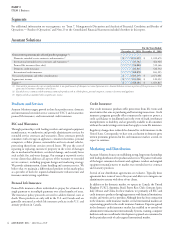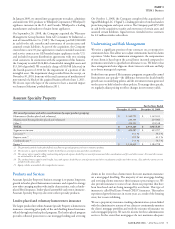Assurant 2010 Annual Report Download - page 20
Download and view the complete annual report
Please find page 20 of the 2010 Assurant annual report below. You can navigate through the pages in the report by either clicking on the pages listed below, or by using the keyword search tool below to find specific information within the annual report.14 ASSURANT, INC. 2010 Form 10K
PART I
ITEM 1A Risk Factors
customers market and distribute our products. Strong competition
exists among insurers to form relationships with agents and brokers of
demonstrated ability. We compete with other insurers for relationships
with agents, brokers, and other intermediaries primarily on the basis of our
fi nancial position, support services, product features, and more generally
through our ability to meet the needs of their clients, our customers.
Independent agents and brokers are typically not exclusively dedicated
to us, but instead usually also market the products of our competitors
and therefore we face continued competition from our competitors’
products. Moreover, our ability to market our products and services
depends on our ability to tailor our channels of distribution to comply
with changes in the regulatory environment in which we and such agents
and brokers operate.
e minimum loss ratios imposed by the Aff ordable Care Act have
compelled health insurers to decrease broker commission levels. Similarly,
the Company recently decreased its commission levels for distribution
channels that market Assurant Health’s individual medical and small
employer group medical products. Although the Company believes
that its revised commission schedule is competitive with those of other
health insurers adapting to the new reform environment, this reduction
could pressure our relationship with the distribution channels that we
rely on to market our Assurant Health products and/or our ability to
attract new brokers and agents, which could materially adversely aff ect
our results of operations and fi nancial condition. In addition, many
of the agents and brokers who distribute Assurant Employee Benefi ts
products make a large part of their living from sales of health insurance.
To the extent that some of them decide to pursue other occupations,
the resulting loss of distribution could have a material adverse impact
on the sales of Assurant Employee Benefi ts’ products.
We have our own sales representatives whose distribution process varies
by segment. We depend in large part on our sales representatives to
develop and maintain client relationships. Our inability to attract and
retain eff ective sales representatives could materially adversely aff ect
our results of operations and fi nancial condition.
General economic, fi nancial market and political
conditions may materially adversely aff ect our results
of operations and fi nancial conditions. Particularly,
diffi cult conditions in fi nancial markets and the global
economy may negatively aff ect the results of all of
our business segments.
General economic, fi nancial market and political conditions may have
a material adverse eff ect on our results of operations and fi nancial
condition. Limited availability of credit, deteriorations of the global
mortgage and real estate markets, declines in consumer confi dence
and consumer spending, increases in prices or in the rate of infl ation,
continuing high unemployment, or disruptive geopolitical events could
contribute to increased volatility and diminished expectations for the
economy and the markets, including the market for our stock. ese
conditions could also aff ect all of our business segments. Specifi cally,
during periods of economic downturn:
•
individuals and businesses may (i) choose not to purchase our
insurance products, warranties and other related products and services,
(ii) terminate existing policies or contracts or permit them to lapse,
(iii) choose to reduce the amount of coverage they purchase, and
(iv) in the case of business customers of Assurant Health or Assurant
Employee Benefi ts, have fewer employees requiring insurance coverage
due to reductions in their staffi ng levels;
•
clients are more likely to experience fi nancial distress or declare
bankruptcy or liquidation which could have an adverse impact on the
remittance of premiums from such clients as well as the collection of
receivables from such clients for items such as unearned premiums;
•
disability insurance claims and claims on other specialized insurance
products tend to rise;
•
there is a higher loss ratio on credit card and installment loan insurance
due to rising unemployment and disability levels;
•there is an increased risk of fraudulent insurance claims;
•
insureds tend to increase their utilization of health and dental benefi ts
if they anticipate becoming unemployed or losing benefi ts; and
•
substantial decreases in loan availability and origination could reduce
the demand for credit insurance that we write or debt cancellation or
debt deferment products that we administer, and on the placement
of hazard insurance under our lender-placed insurance programs.
In addition, general infl ationary pressures may aff ect the costs of
medical and dental care, as well as repair and replacement costs on our
real and personal property lines, increasing the costs of paying claims.
Infl ationary pressures may also aff ect the costs associated with our
preneed insurance policies, particularly those that are guaranteed to grow
with the Consumer Price Index (or “CPI”). Conversely, defl ationary
pressures may aff ect the pricing of our products.
Our earnings could be materially aff ected by an
impairment of goodwill.
Goodwill represented $619,779 of our $26,397,018 in total assets as
of December 31, 2010. We review our goodwill annually in the fourth
quarter for impairment or more frequently if circumstances indicating
that the asset may be impaired exist. Such circumstances could include
a sustained signifi cant decline in our share price, a decline in our actual
or expected future cash fl ows or income, a signifi cant adverse change in
the business climate, or slower growth rates, among others. Based on our
2010 annual goodwill impairment test, we determined that our Assurant
Health and Assurant Employee Benefi ts reporting units experienced an
impairment of $306,381. Based on the same test, it was determined
that the goodwill assigned to our other two reporting units were not
impaired. Circumstances such as those mentioned above could trigger
an impairment of some or all of the remaining goodwill on our balance
sheet, which could have a material adverse eff ect on our profi tability.
For more information on our annual goodwill impairment testing and
the goodwill of our segments, please see “Item 7—MD&A—Critical
Factors Aff ecting Results—Value and Recoverability of Goodwill.”
Competitive pressures or regulators could force us
to reduce our rates.
e premiums we charge are subject to review by regulators. If they
consider our loss ratios to be too low, they could require us to reduce
our rates. In addition, competitive conditions may put pressure on
our rates. In either case, signifi cant rate reductions could materially
reduce our profi tability.
























